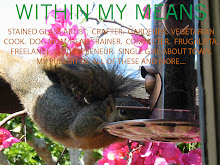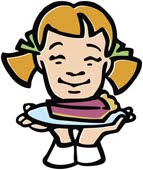After the midterm of my culinary class, we waded into soup territory. Squash soup is one of my favorites to eat, though I don't often make it. This one sounded wonderful, but our school's kitchen stocks only meat stocks. Had I been able to substitute veggie stock, I would have loved to sample it. I was so bummed out that once again I was cooking something I couldn't eat that I didn't even take a picture of the soup itself. The garnish, however, was heaven--apples sauteed in butter and brown sugar! I focused on that. It will make a great topping for any fall soup, like split pea or cauliflower bisque. Yum, soup!
Butternut Squash Soup with Caramelized Apples
Yield: 1 Gallon
4 oz. French Bread
1 oz. Butter
1 oz. Butter
4 oz. Onions, small dice
4 oz. Leeks, small dice
6 oz. Carrots, small dice
2 lb. Butternut Squash, medium dice
3 Qt. Chicken or Vegetable Stock
3/4 tsp. Salt
1/4 tsp. White Pepper
1/4 tsp. Allspice, ground
1/4 tsp. Ginger, ground
12 ea. Croutons
3/4 lb. Apples, tart, firm cooking
3/4 oz. Butter
1 oz. Brown Sugar
6 oz. Heavy Cream
Directions:
1. Cut the bread into 1/2 inch thick slices and fry the bread in 1 oz. butter until golden brown.
1. Cut the bread into 1/2 inch thick slices and fry the bread in 1 oz. butter until golden brown.
2. In a heavy sauce pot heat 1 oz. butter over moderately low heat.
3. Add the onions, leeks, and carrots. Sweat until they are about half cooked. Do not brown.
4. Add the squash, stock, and bread. Simmer until the vegetables are tender.
4. Add the squash, stock, and bread. Simmer until the vegetables are tender.
5. Puree the soup with a food mill, then bring the soup back to a simmer.
6. Prepare the croutons.
7. Peel and core apples. Cut into small dice. Heat 1 oz butter in a saute pan and add the apples and sugar. Cook over moderate heat until the apples are brown and caramelized.
8. At service, if used, heat the heavy cream and add to the soup.




















